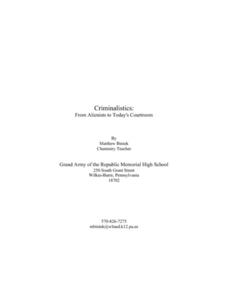Curated OER
Molecular Evolution in Plants
Students are using a paper chromatography study that is suitable for introductory biology. The absorption spectra studies and gel electrophoresis studies are appropriate for students who have complete both introductory biology and...
Curated OER
The Perils of Drinking Water
Learners determine the presence of drugs in water. In this chemistry lesson, students experiment on water samples using thin layer and column chromatography. They determine the concentration of drugs present using graphical analysis.
Curated OER
Chlorophyll
Learners use thin layer chromatography, TLC, to separate various pigments found in plants.
Alabama Learning Exchange
What Color Are The Leaves?
Young scholars identify the colors in leaves. In this chromatography instructional activity, students read the book Why Do Leaves Change Color? and construct chromatography strips to identify the colors of leaves.
Curated OER
Thin Layer Chromatography (TLC) Separation of Plant Pigments - Chlorophyll, Carotene
Students use TLC separations to identify various substances. In this chlorophyll lesson students separate pigments found in different plants.
Curated OER
Ink Analysis and Thin Layer Chromatography
Students explain the process of TLC. They identify at least three components of ink. They analyze data and make conclusions based on laboratory observations.
Curated OER
Can Chromatography Separate A Pigment?
High schoolers separate a mixture of pigments with ion exchange chromatography and predict whether the ion-exchange matrix is positively or negatively charged based on the type of pigment bonded to the matrix.
Curated OER
DNA Fingerprinting
Students experiment with chromatography as a technique which is similar to electrophoresis that scientists use to identify DNA samples.
Cornell University
Forensic Science: Case of the Missing Diamond Maker
Someone stole a diamond-making machine. Who done it? Scholars use forensic science at six different stations to determine the culprit. They analyze fingerprints, use their senses, and complete chemistry experiments to determine the...
Curated OER
Activities for a High School Instrumentation Course
The intent of this series of activities is to introduce high schoolers to the field of chemical instrumentaiton. They perform a few basic chemistry lab techniques: pH titration, paper, gas, and liquid chromatography, ultraviolet and...
Curated OER
What is Forensic Science? Website and Worksheets
In this science website and worksheets, learners read the definitions and applications of forensic science. They read about DNA, fingerprints, and handwriting analysis. They carry out an ink chromatography experiment and record the...
Curated OER
Science: Leaf Study
First graders go on a leaf-hunting expedition around the schoolyard. They determine from which trees they fell using identification cards. Students read several books about leaves and apply their artistic skills by using the collected...
Curated OER
Science: Criminalistics - A New Look at Crime
Students examine the world of forensic science, focusing on fingerprint analysis. In the lesson, they implement a method by which fingerprints of class members are categorized and identified. Elementary students study classification...
Curated OER
Flower Pigments
Middle schoolers experiment with Thin Layer Chromatography to separate pigments found in flower petals.
Curated OER
Plant Pigments
Students investigate the components of chlorophyll. They use paper chromatography to separate the many pigments of chlorophyll from one another.
Curated OER
The Tests of Fluids for Excess Glucose, Amino Acids and Salicyclic Acid
Learners test fluids for amino acids, glucose and salicyclic acid. In this chemistry indicators lesson plan, students use chromatography paper, Benedicts solution and iron chloride to test solutions for amino acids, glucose, and...
Curated OER
Chlorophyll
Students explain the importance of chlorophyll in plants. In this biology lesson, students extract chlorophyll from different plant sources using chromatography. They discover the different factors needed for photosynthesis to take place.
Curated OER
Color Change in Leaves
High schoolers identify the different leaf pigments and colors. In this biology lesson, students perform chromatography to separate them. They explain how light affects green leaf colors and causes falling leaves in autumn.
Curated OER
Auxin: Indole-3-Acetic Acid
Students identify auxins from their structural formulas. They understand the process of refluxing in chemical synthesis. Students perform thin layer chromatography using silica gel plates to differentiate chemical substances.
Curated OER
Crime Scene Documentation
Students become forensic investigators. In this crime scene lesson, students go to the science lab which is the "scene of the crime." They collect evidence such as fingerprints, "blood" evidence, chromatography, footprints, and more.
Beyond Benign
Gelin’: Gel Electrophoresis Simulation
Take a look at a DNA fingerprint. Scholars run a gel electrophoresis simulation to examine the DNA of potential father cats in the eighth installment of an 18-part series. The lesson continues the series that explores DNA and its...
Kenan Fellows
An Analytical Chemist, a Biochemist, an Animal Scientist, and an Oncologist Walk into a Lab...No Joke
Oncology presents multiple opportunities for research and the collaboration of many different types of scientists. Scholars divide into groups and research the history of mass spectrometry, polarity/non-polarity,...
Curated OER
Science NetLinks: Color Burst
Students gain experience in asking questions and conducting inquiry by exploring the separation of colors in water and other solvents; to communicate and share findings of student investigations.
Curated OER
Separation of Unknowns in a Liquid
Students identify the different components of a given sample using chromatography. In this chemistry lesson, students compare paper and column chromatography. They collect data and construct data tables.
Other popular searches
- Column Chromatography
- Paper Chromatography
- Chromatography Lab
- Chromatography Forensics
- Chlorophyll Chromatography
- Ink Chromatography
- Plant Chromatography
- Crime Scene Chromatography
- Thin Layer Chromatography
- Chromatography Pigment
- Gas Chromatography
- Leaf Chromatography

























